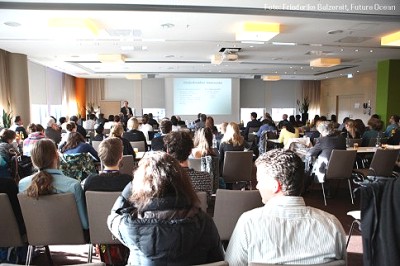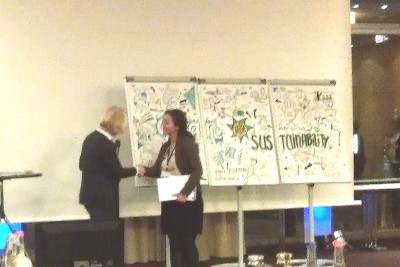Impressions by Dr. Annette Breckwoldt, Leibniz Center for Tropical Marine Ecology (ZMT) Bremen
 “Can we use the ocean in a sustainable way?” This was the central question of the first Kiel Ocean Sustainability Science Symposium. It took place on Kiel’s “Waterkant” (shoreline) with an ambitious programme to pick on more than 120 brains from the natural and social sciences, humanities, NGOs, politics, the interested public and an encouraging number of young and early career scientists.
“Can we use the ocean in a sustainable way?” This was the central question of the first Kiel Ocean Sustainability Science Symposium. It took place on Kiel’s “Waterkant” (shoreline) with an ambitious programme to pick on more than 120 brains from the natural and social sciences, humanities, NGOs, politics, the interested public and an encouraging number of young and early career scientists.
I was among the fortunate people invited to join the three days of lively discussion focused on this question with a number of inspiring ‘marine’ experts – in the most inter- and transdisciplinary sense:
The Excellence Cluster “Future Ocean” had ensured excellent meeting conditions with alternations between keynote addresses in the morning and four workshop sessions each afternoon. The parallel workshops debated the following themes:
-
Introduction to Ocean Governance – Capacity Building for the Future (organised by Larry Hildebrand)
 I joined this workshop and was rewarded with a truly interesting discussion sustained by six international students of the World Maritime University (UN-WMU, Malmö, Sweden) coming from The Gambia, Ghana, Bangladesh, South Africa, Brazil and Pakistan. The important take home message was that an ‘enabling environment’ needs to be developed first within the countries, before durable capacity building can actually take place. One student illustrated that point: the country needs her expertise, but there is no position she can apply to when going back home after her studies. How can she apply what she has learned and thus contribute to her country's sustainable coastal development?
I joined this workshop and was rewarded with a truly interesting discussion sustained by six international students of the World Maritime University (UN-WMU, Malmö, Sweden) coming from The Gambia, Ghana, Bangladesh, South Africa, Brazil and Pakistan. The important take home message was that an ‘enabling environment’ needs to be developed first within the countries, before durable capacity building can actually take place. One student illustrated that point: the country needs her expertise, but there is no position she can apply to when going back home after her studies. How can she apply what she has learned and thus contribute to her country's sustainable coastal development?
-
Ocean Planning and Indicators (organised by Martin Visbeck and Martin Quaas)
The main conclusion with regards to the post 2015 Sustainable Development Goals (SDGs) was that it would be wise to cluster some of the SDGs to avoid fragmentation and overlap between interconnected issues. Streamlining (inter-)national funds and efforts is considered beneficial. For example, pollution will be tackled under the SDG 14 on oceans and coasts, but will certainly have effects on biodiversity as well. Biodiversity in turn is tackled by another SDG.
-
Preparing for Coastal Change (organised by Nassos Vafeidis)
This group had a strong focus on sea-level rise adaptation and its consequences for the affected countries, their coasts, population and urban centres.
-
Games and Comics for Ocean Sustainability (organised by Jörn Schmidt)
 ‘The group that laughed most’ was what could be gathered even from behind closed doors. This group had some very interesting experiences on games, and how different paths can be found for learning and reflection on the pressing sustainability issues discussed at this meeting. Jörn Schmidt introduced different games and ways of visualisation (e.g. comics) as interactive learning journeys. They differ significantly from the ‘traditional’ learning by reading and listening. This way, they facilitate the uptake and anchoring of information.
‘The group that laughed most’ was what could be gathered even from behind closed doors. This group had some very interesting experiences on games, and how different paths can be found for learning and reflection on the pressing sustainability issues discussed at this meeting. Jörn Schmidt introduced different games and ways of visualisation (e.g. comics) as interactive learning journeys. They differ significantly from the ‘traditional’ learning by reading and listening. This way, they facilitate the uptake and anchoring of information.
These interesting first two days were followed by a special Friday-finale, for which the Centre for Interdisciplinary Marine Sciences (short Kiel Marine Sciences) had invited 11 speakers for a workshop titled ‘Social Sciences in Marine Sciences’. Topics here ranged from social-ecological systems to marine spatial planning and maritime claims and security. The week thus ended with some distinctly intriguing insights and discussions on human-nature interactions, how humans shape the coastal and marine environment and what their future role in it could be in the future. At the end, participants returned to the initial question “Can we use our ocean in a sustainable way?”. In the light of the often disheartening evidence about widespread degradation presented during the symposium, the answer was clearly “Not yet!”.
More information about the symposium is available here.








